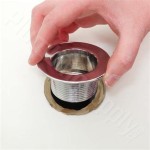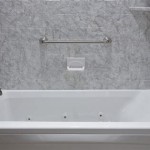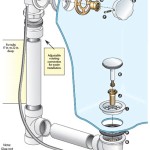Cleaning The Bathtub With Baking Soda: A Comprehensive Guide
Maintaining a clean bathtub is essential for personal hygiene and the overall upkeep of a home. A grimy bathtub can harbor bacteria, mold, and unpleasant odors, making it an unappealing space. While numerous commercial cleaning products are available, baking soda presents a natural, cost-effective, and environmentally friendly alternative. This article provides a comprehensive guide to effectively cleaning a bathtub using baking soda, outlining the necessary materials, step-by-step instructions, and troubleshooting tips.
Baking soda, also known as sodium bicarbonate, is a versatile compound with mild abrasive and deodorizing properties. Its chemical formula, NaHCO3, indicates its composition: sodium, hydrogen, carbon, and oxygen. These properties make it an excellent cleaning agent for various surfaces, including bathtubs. Its mild alkalinity helps to dissolve grease, grime, and soap scum without causing damage to the bathtub's finish. Furthermore, baking soda is non-toxic and safe to use around children and pets, making it a preferable option for households concerned about harsh chemical exposure.
Before embarking on the cleaning process, it is crucial to gather the necessary materials. These materials include baking soda, water, white vinegar (optional), a spray bottle (optional), a scrub brush or sponge, a microfiber cloth, and rubber gloves. The scrub brush should have stiff bristles to effectively remove stubborn stains, while the sponge can be used for gentler cleaning. The microfiber cloth is ideal for wiping down the bathtub after cleaning, leaving a streak-free finish. Rubber gloves protect hands from prolonged exposure to water and cleaning agents, preventing skin irritation. The optional white vinegar enhances the cleaning power of baking soda by creating a fizzing reaction that helps to loosen grime and mineral deposits.
Preparing the Bathtub for Cleaning
The first step in cleaning the bathtub with baking soda involves preparing the area for treatment. Begin by removing any items from the bathtub, such as bath mats, shampoo bottles, and soap dishes. These items can obstruct the cleaning process and may also harbor dirt and bacteria. Thoroughly rinse the bathtub with warm water to loosen any loose debris and grime. This initial rinse helps to prime the surface for the baking soda treatment, making it more effective.
Inspect the bathtub for any areas with significant staining or mildew growth. These areas may require additional attention during the cleaning process. Mildew, in particular, can be difficult to remove and may require a more concentrated application of baking soda or the use of a mildew-specific cleaning solution. Addressing these areas proactively will ensure a more thorough and satisfactory cleaning outcome.
Consider the type of bathtub material before proceeding with the cleaning process. While baking soda is generally safe for most bathtub surfaces, including acrylic, porcelain, and enamel, it is advisable to test a small, inconspicuous area first. This precautionary measure ensures that the baking soda does not cause any discoloration or damage to the bathtub’s finish. If any adverse effects are observed, discontinue the use of baking soda and consider alternative cleaning methods. However, in most cases, baking soda is a gentle and effective cleaning agent for a wide range of bathtub materials.
Applying Baking Soda and Cleaning
After preparing the bathtub, the next step involves applying the baking soda. There are several methods for applying baking soda, depending on the severity of the grime and the desired level of cleaning power. One common method involves creating a baking soda paste by mixing baking soda with a small amount of water. The ratio is typically 3 parts baking soda to 1 part water, but this can be adjusted to achieve the desired consistency. The paste should be thick enough to adhere to the bathtub surface but not so thick that it is difficult to spread.
Apply the baking soda paste to the entire surface of the bathtub, focusing on areas with significant staining or grime. Use a scrub brush or sponge to gently rub the paste into the surface, working in a circular motion. This abrasive action helps to loosen dirt and soap scum. For stubborn stains, allow the paste to sit for 15-20 minutes before scrubbing. This soaking period allows the baking soda to penetrate the grime and make it easier to remove.
An alternative method involves sprinkling dry baking soda directly onto the bathtub surface. This method is particularly effective for deodorizing the bathtub and removing light grime. After sprinkling the baking soda, dampen a sponge or cloth and gently scrub the surface. The moisture activates the baking soda, creating a mild abrasive action that helps to lift dirt and grime. For enhanced cleaning power, consider combining the baking soda with white vinegar.
To use the baking soda and vinegar combination, first sprinkle baking soda onto the bathtub surface. Then, pour white vinegar into a spray bottle and lightly mist the baking soda. The vinegar and baking soda will react, creating a fizzing action that helps to loosen grime and mineral deposits. Allow the mixture to fizz for a few minutes before scrubbing the surface with a brush or sponge. Be aware that the fizzing action generates carbon dioxide gas, so ensure proper ventilation during this process.
Rinsing and Drying the Bathtub
After thoroughly scrubbing the bathtub, it is essential to rinse away all traces of baking soda and grime. Use warm water to rinse the entire surface of the bathtub, ensuring that no residue remains. A handheld showerhead can be particularly useful for this purpose, as it allows for targeted rinsing of specific areas. Pay close attention to corners and crevices, as these areas tend to accumulate baking soda residue.
Once the bathtub has been thoroughly rinsed, use a clean microfiber cloth to dry the surface. This step helps to prevent water spots and streaks, leaving the bathtub looking clean and polished. A microfiber cloth is ideal for this purpose because it is highly absorbent and lint-free. Alternatively, allow the bathtub to air dry, but be aware that this may result in water spots, particularly in areas with hard water.
Inspect the bathtub for any remaining stains or grime. If necessary, repeat the cleaning process in these areas. For particularly stubborn stains, consider using a more concentrated baking soda paste or a specialized cleaning solution. Maintaining a consistent cleaning routine is crucial for preventing the buildup of grime and ensuring that the bathtub remains clean and hygienic. Regular cleaning, ideally once or twice a week, will help to minimize the effort required for each cleaning session.
In addition to cleaning the bathtub itself, it is important to clean the surrounding areas, such as the shower curtain or door, the grout lines, and the bathroom floor. These areas can also accumulate dirt and bacteria, contributing to an overall unsanitary environment. Using a similar baking soda-based cleaning solution can effectively clean these areas, promoting a healthier and more pleasant bathroom environment.
Proper ventilation is another key factor in maintaining a clean and hygienic bathroom. After cleaning the bathtub, ensure that the bathroom is well-ventilated to prevent the buildup of moisture, which can lead to mold and mildew growth. Opening windows or using an exhaust fan can help to improve air circulation and reduce humidity levels. This practice is particularly important in bathrooms with poor ventilation or those located in humid climates.
By following these steps, individuals can effectively clean their bathtubs using baking soda, a natural, cost-effective, and environmentally friendly cleaning agent. Regular cleaning and proper maintenance will help to keep the bathtub clean, hygienic, and inviting.
How To Clean Your Tub Naturally Even When It S Really Gross Note Trash

How To Clean A Bathtub The Right Way In 9 Easy Steps

How To Clean A Jetted Tub No More Gunk In The Water Bob Vila

How To Clean A Bathtub Deep And After Each Use

How To Deep Clean Your Bathtub Nw Maids

How To Deep Clean A Bathtub Hometalk

Show Your Bathroom Some Love With Baking Soda Vinegar And Soap

How To Clean Your Tub With Baking Soda

Bath Cleaning How To Clean A Bathtub With Baking Soda Express Co

How To Clean An Acrylic Tub Or Shower 9 Best Cleaners








